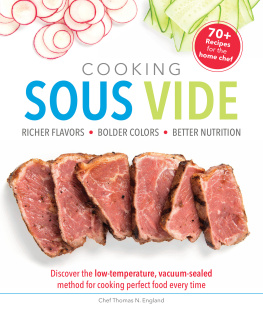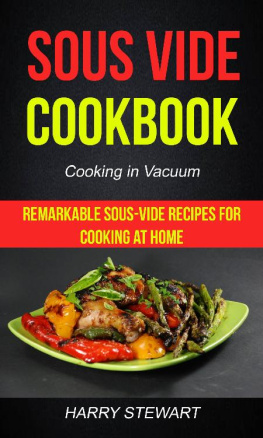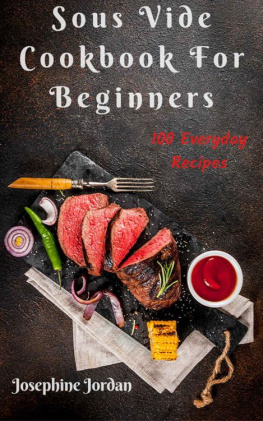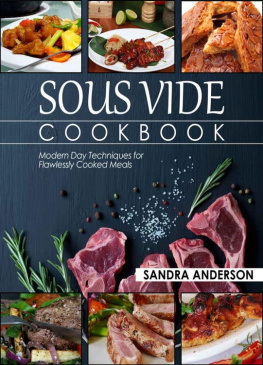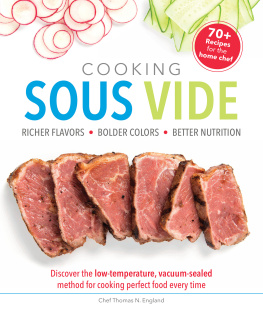Sous Vide Cookbook for Beginners
Sous Vide Cookbook for Beginners
THE COMPLETE COOKBOOK WITH MAIN GUIDELINES AND SOUS VIDE RECIPES FOR COOKING AT HOME! (Modern & Most Delicious Sous Vide Recipes with Tips and Techniques)
Ariana Paola
Copyright@2020 by Published in the United States by Ariana Paola
All Rights Reserved.
No part of this publication or the information in it may be quoted from or reproduced in any form by means such as printing, scanning, photocopying or otherwise without prior written permission of the copyright holder.
Disclaimer and Terms of Use:
Consistent efforts have been made to make sure that the information provided in this book is accurate and complete. However, the author or publisher doesn't guarantee the accuracy of the information, graphics, and text contained within the e-Book mainly due to the rapidly changing nature of research, science, known and unknown facts on the internet. The author and publisher are not held responsible for errors, contra interpretation or any omission regarding the subject. This e-Book is presented mainly for informational and motivational purposes only. This book is presented solely for Cooking and informational purposes only.
TABLE OF CONTENTS
INTRODUCTION
The French concept of sous vide cooking suggests preparing food in a vacuum, at an exact temperature, and with almost no time control. The thermostat-controlled water bath allows cooking sealed food gently and to the desired doneness. In practical terms, sous vide cooking allows for ultimate flexibility in the kitchen. There is absolutely no way that your food can be overcooked. As soon as the exact internal temperature is reached, it stays there within that sealed vacuum bag. This technique maintains the food in its juices with no volume loss.
Think of sous vide as storing the food. When you are cooking a steak in a regular pan, you need about 10 minutes and constant moving and turning the steak over. When you are cooking sous vide you throw the sealed steak into the water container and if you go away, nothing is going to happen if you get back late.
The recipes in this book are separated by food type. The first chapter is white meat recipes. White meat refers to the light-colored meat of poultry and rabbits. It is a lean source of protein with a low percentage of fat.
Red meat refers to the muscle meat of beef, pork, or other cattle. It has a high level of fat; contains iron, zinc, vitamin B, and myoglobin, which is the compound responsible for providing oxygen to the muscles.
The next chapter covers fish and seafood recipes. In general, it takes a shorter time to cook sous vide fish than meat due to its delicate nature. The cooking time, however, is also based on thickness. It is highly recommended to use fish that is very fresh and safe to eat raw.
The last chapter offers fruits and vegetables. Almost all vegetables and fruit are cooked at 183F since pectin breaks down above 180F. The higher the pectin content, the firmer the fruit is. Pectin is also responsible for preserving the fruit and turns to gel at high temperature. You can sous vide any seasonal fruit or vegetable and try out various spices and seasonings, creating your own recipes. As long as you have the right time-temperature balance, you are safe.
Some recipes call for marinade time. In these cases, you can store the cooking bags in the fridge and cook at any time later.
The recipes do not say how many cooking bags exactly to use. This is because this is up to your convenience; the main rule is to place the food in a single layer and never in piles. But at the same time, you can use several cooking bags leaving enough space for water to circulate. In view of this, you had better have several cooking bags in-store, the large ones as well and make a choice of your own.
What are Sous-Vide?
Sous Vide is a cooking method that utilizes slow, precise cooking temperature and results in restaurant-grade meals that are not only consistent but are also incredibly delicious. This cooking technique has been around for a long time, but it only reached its hype recently, thanks to the simple-to-use and pocket-friendly Sous Vide equipment.
Sous Vide, which means under vacuum in French, is the process of vacuuming the food, usually in a bag and cooking in the water at a precise temperature. This may seem fancy, but other than the fancy dishes, there is nothing complex about the cooking method. The process is super simple, and it involves only three cooking steps:
- Attach the Sous Vide Machine to a pot of water and set the exact cooking temperature.
- Place the food in a sealable bag, get rid of the excess air, and seal it.
- Immerse the bag in the preheated water and cook for as long as you need to get the best results.
If you want to add a crispy exterior layer, you can finish your food by searing or grilling it.
Why Sous Vide?
Sous Vide is probably the most precise cooking method, thanks to the circulation of the temperature. There is no other small kitchen appliance on the market that can offer similar results. Because it has a cooking technique that can be controlled down to a single degree, this cooking method offers tender and extremely flavorful dishes.
How To Cook Sous Vide?
Cooking Sous Vide is much easier than you think. Before you start cooking, you need to have the proper equipment. When it comes to ingredients, you do not have to give them some special attention. Most of the components just need some basic spices to shine.
To get started, you will need to fill your Sous Vide machine with water and preheat water to the desired temperature.
While your water is heating, you can prepare the ingredients. Season the ingredients to taste, and place in individual Sous Vide bag. We are saying special bags, as you cannot use plain bags. Any other type of bag may leak in, and destroy your elements. Only bags specially designed for the Sous Vide cooking is appropriate to use.
Once the components are in the right bag, you need to vacuum them. Use a vacuum sealer to remove all air from the pack. If you do not have a vacuum sealer, you can do the vacuuming with a water bath method. For the vacuuming ingredients with a water bath, gently place the filled bag into a water bath, making sure the water does not enter the container. Let the pressure of water press the air through the top of the bag. When the air is out (or the most is out) seal the bag above the waterline.
Once you complete these steps, it is time to cook the food.
The Sous Vide Cooking is all about temperature and measuring as these factors will determine the texture and the flavor of your dish. Selecting the correct temperature is essential.
Sous Vide cooking temperature is in a range of 115 -190 F, and always below boiling. The key to successful sous vide cooking is maintaining a constant temperature through the baking period. Just one degree below or above can change the final flavor and appearance.
Cooking Temperatures
There is no single rule for sous vide cooking temperatures, but there is a range of cooking times suitable for every type of food. The lower the temperature the longer the cooking time is.
Below are the suggested temperature charts for beef and pork, followed by tables for poultry, fish and seafood, vegetables, and fruit.


